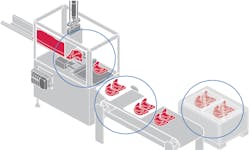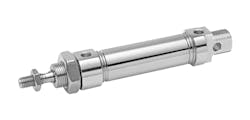Download this article in pdf format.
Manipulating food-grade pneumatics equipment without proper care isn’t an option for the food and beverage industries. Food and packaging machines and equipment are held to stringent national and international quality and hygiene standards. This places high demands on machine designers to commission pneumatic systems with excellent compressed air quality and hygienic designs.
1. Prioritize Hygienic Design
Machinery intended for use with food and beverage products, cosmetics or pharmaceutical products must be designed and constructed to avoid any risk of contamination, according to a number of current standards and directives.
The demands of food and beverage applications make it critical that pneumatic components, in particular, be made of corrosion-resistant, non-toxic, non-absorbent materials. Food processing and packaging machine suppliers primarily rely on materials like metals, plastics, glass or ceramics. When designed with these materials and with hygiene in mind, the machine and its components are easy to clean and the risk of contamination is minimized.
In addition, the materials used must not react to cleaning agents or disinfectants. They should be designed to prevent food residues and microorganisms from sticking, and they cannot contaminate the final product or its packaging. Choose components that are resistant to contaminant accumulation and avoid designs having areas that cannot be cleaned properly.
2. Know the Food Zones
Typically, the food and beverage industry will differentiate between three processing zones, each requiring different standards:
- Food zone: The food comes into direct contact with the surface of a machine.
- Splash zone: The food or beverage can come into contact with machine parts but is then removed from the handling process.
- Non-food zone: The food does not come into contact with the machine or individual components. Final packaging takes place in this zone.
Components must be easy to clean, particularly in both the food and the splash zones.
3. Understand the Applicable Standards and Regulations
National and international standards and guidelines play a significant role in designing machines used to produce food and beverage products. It is important to know these standards and regulations that apply in your manufacturing location as well as the right set of regulations required for the destination where the machine will be used.
Depending on your location, selection of the right pneumatic components may be guided by:
- EU Regulation on the hygiene of foodstuffs (852/2004 EC)
- FDA CFR Title 21
- ISO 21469
- 1935/2004/EG
- NSF/ANSI 51
- NSF-H1
Compliance with high requirements for hygiene offers an added benefit: It extends the device’s service life and reduces maintenance effort considerably. Also, be sure that the selected devices and components use only food-grade seals and lubricants.
4. Consider Component Wear and Tear
In addition to offering specific surface and material properties, pneumatic components for the food and beverage industry must be robust enough to withstand frequent cleaning processes.
For instance, the CL03 washdown directional control valve series with its hygienic design and Ingress Protection rating of IP69k can be used without the need for a closed cabinet in washdown areas. These procedures can vary within the industry. For example, depending on where the components are used, companies may apply different cleaning processes, such as high-pressure cleaning and cleaning with chemical agents. Fully understanding how the pneumatics will be used is key to sourcing components that can withstand the rigors of your application.
5. Understand the Benefits and Efficiencies of Using Pneumatic Components
Pneumatic systems can be optimized for high energy efficiency when designed properly. Actuators should be sized to the application considering the necessary force, pressure, and mechanical limitations. Online sizing software and cylinder configuration tools can support and reduce the engineering effort substantially. Installing the correct pneumatic valve near an actuator not only provides efficient flow requirements for the cylinder to move the load but can also reduce the cycle time of the cylinder by optimizing the overall machine performance.
Users can precisely set pressure with mechanical or electro-pneumatic pressure regulators, allowing for efficient energy use and optimized processes. Precise pressure control ensures that only the needed amount of energy is used for the respective process. With some products, custom pressure control may be possible. On a machine with vacuum components, you can create additional energy efficiency by using an integrated vacuum sensor to automatically switch pressure on and off when a vacuum level has been achieved.
Pneumatics circuits can be designed with shorter airflow paths that require less volume and enable smaller tubing diameters and lengths, thus increasing the overall efficiency.
6. Look for Opportunities to Incorporate Intelligent Pneumatics
Industrial Internet of Things (IIoT) technology can anticipate wear and tear before it leads to machine downtime and energy loss. From sensors that detect and minimize leaks to those that monitor pressure and consumption, intelligent pneumatics enables machine manufacturers and end-users to significantly increase equipment run-time availability and reduce machine servicing requirements. Intelligent pneumatic solutions can be seamlessly integrated into various IIoT scenarios, such as monitoring cylinder performance and alerting the user when cycle time is not within the threshold. Monitoring the current flow rate of the equipment based on the desired flow curve will increase the efficiency of the machine.
7. Leverage Specialist Knowledge and Application Expertise
Not all companies have the internal resources to design, build, and commission pneumatic solutions. Teams not consistently involved in laying out pneumatic systems experience a learning curve that costs time and money. A supplier with both knowledge and application expertise can help free engineering resources and simplify procurement. These experts offer knowledge in the latest-generation products as well as the experience that comes from having built numerous systems. Whether they’re recommending individual cushioning adjustments or determining the right dimensioning, they can help maximize results. Qualified suppliers may also offer pre-assembled actuator control systems to reduce engineering time. At Emerson, for instance, pneumatic specialists can provide additional resources for the design and implementation of “pneumatic positioning systems,” which use IIoT and advanced feedback control like the AES module. These systems can be easily designed to monitor the correct position of a cylinder and load while sending valuable machine data back to a PLC for analytics and predictive machine repair.













